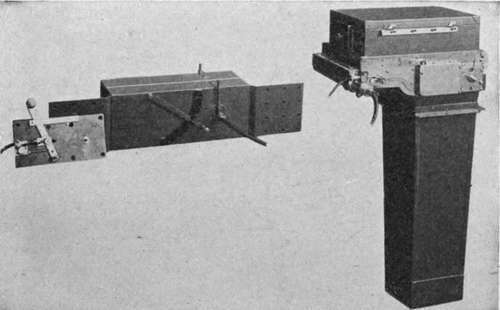Folmer 13x18 Centimeter Automatic Camera
Description
This section is from the book "Airplane Photography", by Herbert E. Ives. Also available from Amazon: Airplane photography.
Folmer 13x18 Centimeter Automatic Camera
This camera, also never manufactured in quantity, is shown in Fig. 53, and a sketch of its manner of operation is included in by the motion of a rack, which is part of the magazine and which is driven by a toothed pinion, also part of the magazine, which in turn engages in a toothed wheel projecting upward from the camera body. This toothed wheel is turned first in one direction and then in the other by an arrangement of gears and levers driven by the source of power, which as shown in Fig. 53 is a wind turbine connected through a flexible shaft. Operation is either automatic or semiautomatic as desired, and the camera can be put through its cycle by hand if necessary the ensemble of automatic camera diagrams (Fig. 52). Its most distinctive feature is perhaps the use of a two compartment magazine. This is similar in form to the one already described in connection with the hand-held cameras, but larger, to hold eighteen 13X18 centimeter plates. The unexposed plates are placed in one compartment, and after exposure are shifted to the other. The transfer is effected As with several other designs, the completion of the working model of this camera occurred after agreements had been reached by the Allies, as to plate size, standard lens cones, and other features, not easily incorporated in it, thus making manufacture inadvisable. The validity of the design for peace-time work is, of course, not affected by this fact.

Fig. 53. - Folmer 13x18 centimeter automatic and semi-automatic plate camera.
Continue to:
Tags
camera, lens, airplane, aerial, film, exposure, photography, maps, birdseye
